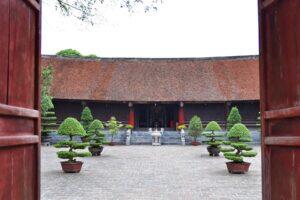Fodor's Expert Review National Museum of Vietnamese History
Opened in 1932 by the French, this building has served in its present capacity since 1958, when it was turned it over to Hanoi authorities. The ground floor houses treasures from early history, particularly Vietnam's Bronze Age. Of special interest are the Ngoc Lu bronze drums, vestiges of this period some 3,000 years ago that have become enduring national Vietnamese symbols. Tools from the Paleolithic Age are on display, as are ceramics from the Ly and Tran dynasties. Painstakingly elaborate but somewhat corny dioramas depict various Vietnamese victories over hostile invaders. Upstairs, exhibits focus on more recent Vietnamese history. Standouts include 18th- to 20th-century bronze bells and khanh gongs (crescent-shape, decorative gongs); Nguyen-dynasty lacquered thrones, altars, and "parallel sentence" boards (Chinese calligraphy on lacquered wood carved into shapes of cucumbers, melons, and banana leaves); and an entire wing devoted to 7th- to 13th-century Champa stone carvings.
As... READ MORE
Opened in 1932 by the French, this building has served in its present capacity since 1958, when it was turned it over to Hanoi authorities. The ground floor houses treasures from early history, particularly Vietnam's Bronze Age. Of special interest are the Ngoc Lu bronze drums, vestiges of this period some 3,000 years ago that have become enduring national Vietnamese symbols. Tools from the Paleolithic Age are on display, as are ceramics from the Ly and Tran dynasties. Painstakingly elaborate but somewhat corny dioramas depict various Vietnamese victories over hostile invaders. Upstairs, exhibits focus on more recent Vietnamese history. Standouts include 18th- to 20th-century bronze bells and khanh gongs (crescent-shape, decorative gongs); Nguyen-dynasty lacquered thrones, altars, and "parallel sentence" boards (Chinese calligraphy on lacquered wood carved into shapes of cucumbers, melons, and banana leaves); and an entire wing devoted to 7th- to 13th-century Champa stone carvings.
As you explore the museum, be sure to consult the English-language brochure you are given with the purchase of your entrance ticket, as the information it contains about the exhibits is nearly the only information on hand. Displays provide little explanatory text, even in Vietnamese, and English-language translation is lacking. It's possible to arrange English-speaking museum guides in advance.
READ LESS






